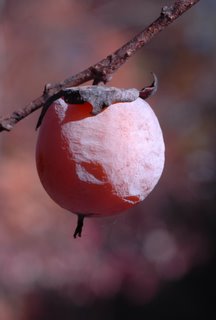
There is a persimmon tree in my yard. It sits atop a steep bank at the east edge of a small clump of woods where it sees morning sun. Its fallen fruits roll the few feet down the little hill and stop within arm’s reach of the stone wall that edges my driveway and happens to provide a perfect place to sit and eat persimmons.
I see them as I stand in front of the kitchen sink with my first cup of coffee, the white, double-hung window behind it perfectly framing the scene, chilly, with just a splash of early morning sun. Today, I can count thirteen persimmons from this window, all hanging on thin limbs that lost the last of their leaves to last night’s late November wind and rain. The persimmons hung on bravely through the storm and now rest quietly under a perfect Carolina blue sky. One dangles by itself at the very end of a limb, bending it downward like the ornament on Charlie Brown’s Christmas tree. Others grow in clumps on stronger branches.
It isn’t much of a tree, truth be told, perhaps two inches in diameter, growing wild and crowded by the underbrush. Depite the odds, it has managed to reach a height of about ten feet. Tall, gangly and thin, it reminds me of me, I suppose. The fruit isn't much to brag about, either. The day we discovered the tree at our new home, my mother-in-law warned me never to eat the fruit until after it falls from the tree, lest I "pucker myself to death". Others say you shouldn't eat the fruit until after the first frost. But that's a lesson I learned early in life.
My great-grandmother and a persimmon tree are the subjects of my earliest memory. I called her “Bombo” for whatever reason four-year olds choose to name their elders. My grandparent’s lived in a small house in a small town in western Kentucky on the corner of Kiegan Street and an alley that, like my new home, had a stone wall running along one side, just high enough to sit on, with a large persimmon tree growing next to it.
Perhaps it wasn’t actually so large. I remembered the wall being about three feet high until I drove by decades later and noticed that it was barely a foot higher than the little alley it borders. I suppose that was the perfect height for a four-year old to sit, but I concede that the giant, spreading persimmon tree of my memory might not have been much taller than the one outside my kitchen window this morning.
On that warm fall day many years ago, Bombo sat next to me on that wall and we ate sweet, delicious persimmons. I remember the taste, the color, the texture, the day, the warmth of the sun, the long cotton dress she used to hold the persimmons we gathered, and I remember her smile. I hope she enjoyed that day as much as I did. By the time the persimmons were once again ripe, she was no longer with us. I feel privileged to have had even a little time with a great-grandparent. Not everyone gets the opportunity. I was her first great-grandchild and the only one she would know.
Early the following autumn, I noticed the fruits on the tree and rushed inside to ask Bombo to help me eat the persimmons. She told me that we couldn’t eat them until they had been “frosted on”. Undaunted, I went to my grandmother, Bombo’s daughter, and asked her to frost on the persimmons for me.
I suspect that most people aren’t that familiar with persimmon, except perhaps as a decorator's paint color that goes well with ecru. Grown commercially in California, persimmons rarely show up in the produce department of your local grocery. I read that persimmons are quite popular in Japan and China, but the Asian variety is less astringent, ripens on the tree and doesn’t require the chemical reactions of the first frost to break down the tannin and release its sweetness. California growers graft the Asian variety to North American root stock to get the best characteristics of both varieties. The domestic tree is an attractive landscape plant because it grows in a wide range of conditions, has few pest and disease problems, and grows lovely foliage, flowers and fruit, but it doesn’t appear to be commercially viable. So, persimmons will likely remain somewhat exotic here.
Which is just fine with me. I'm not sure I would even remember having shared an apple with my great-grandmother at the age of four.
My struggling little persimmon tree with its few ripe fruits is much more than a scrawny, wild fruit tree to me. It’s a treasure. It's a sign. What are the odds of buying a home in town and finding a wild persimmon tree growing next to its stone wall?
I’m going to nurture it, but I’m also going to plant my own. I’ll plant one of the new trees on the same bank, near its wild, native cousin and my new stone wall, so someday perhaps I can sit on that wall and share a persimmon with a grandchild or, God willing, a great-grandchild, just like Bombo and me.
Wonder what he'll call me.




No comments:
Post a Comment